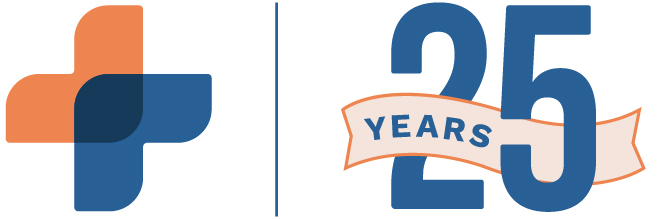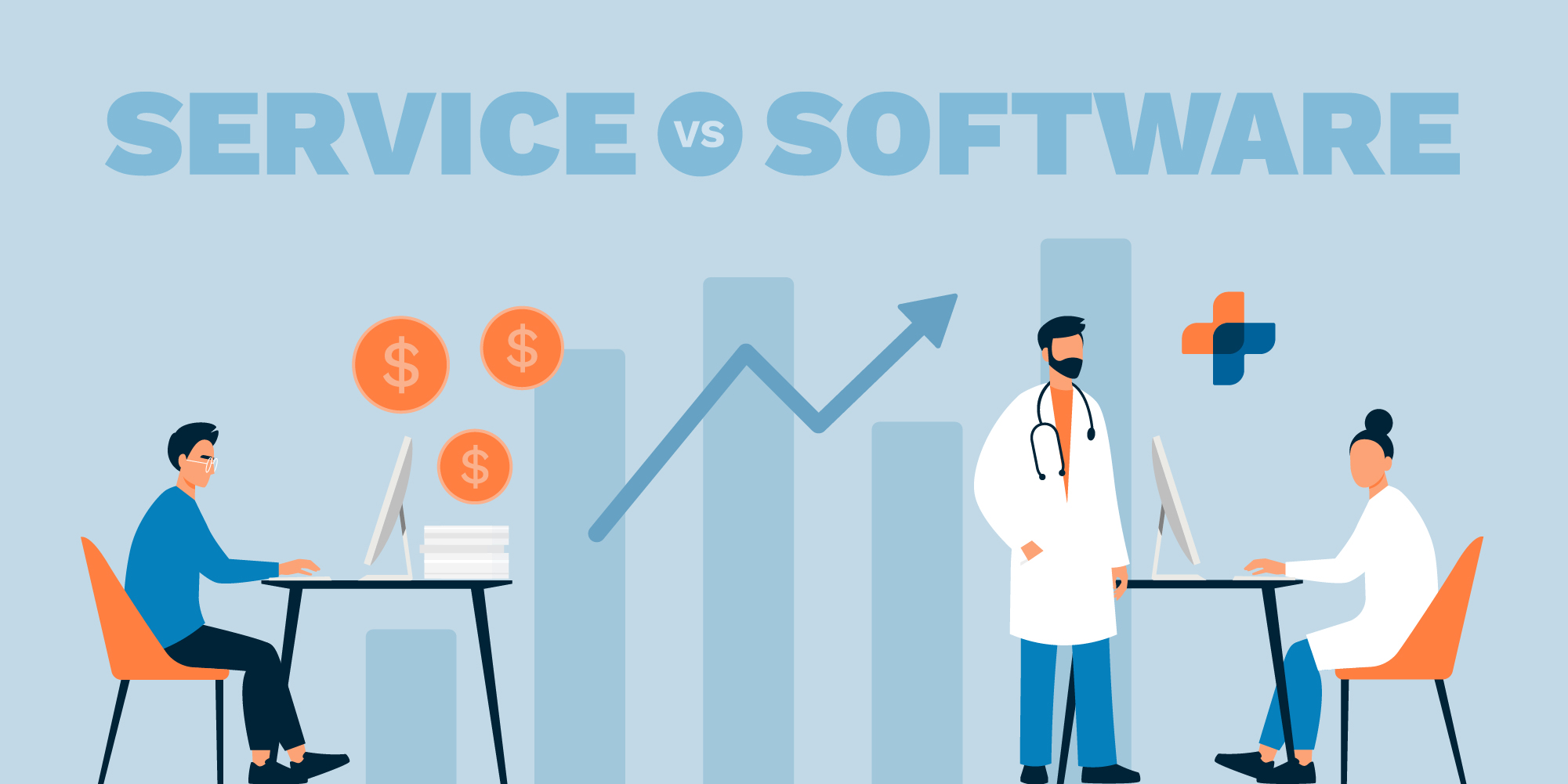According to practitioner polls, 83% of small to medium-sized practitioners said that slow payments are their top practice challenge, while 81% said that the second-highest challenge was proper communication of patient payment accountability.
To solve the issue of slow payments, increase transparency for patients, and ultimately close the revenue loop, practices have a few options. These options include outsourcing your medical billing with a third-party managed billing service or using integrated in-house billing software to take ownership of the process. The right solution for your practice depends on a host of factors, but we’ll cover the differences, pros and cons, and cost comparisons so that you can make a billing decision that’s right for you.
What are Medical Billing Services?
Managed medical billing services allow providers and practices to outsource their revenue cycle management to third-party staff who navigate between patients, healthcare providers, and payers to arrange for collection and reimbursement of medical services. It is estimated that 38.5% of healthcare companies work with a single vendor who oversees all facets of the Revenue Cycle Management (RCM) medical billing process.
Outsourcing work to a third-party medical billing service ensures that your practice has trained staff whose sole commitment is to deal with billing, coding, claims, collections, and more. This relieves practice staff from administrative burden, streamlines workflows, reduces submission errors, and more quickly closes payment cycles.
However, medical billing services costs can be difficult to predict. Billers must collect and/or verify information including patient demographics, medical history, insurance coverage, and services received—plus manage the processing, tracking, submission, and follow-up on health insurance claims. Billers verify coverage with patient insurance plans and generate and code medical claims, check for accuracy, and submit claims to payers. Once payers approve the claims, the claims are returned to billers. Billers then prepare the patient’s bill by deducting the amount covered by the payer from the cost of the procedure or service, factoring copays and deductibles, and then communicating the outstanding balance with patients.
What is Medical Billing Software?
Medical billing software is an automated health technology system—typically cloud-based or server-based—that provides a cost-efficient, transparent way to quickly manage the revenue cycle. Billing software streamlines the process of billing in-house while preventing mistakes (which some studies show occur in 4 out of 5 medical bills), enhancing patient experience, and working within a streamlined, integrated interface that you may already be familiar with.
Medical billing software is built to be agile and integrate with electronic health records (EHR), electronic prescribing (ERX), and other tools so that healthcare data is seamlessly accessible for administrative staff and patients, ensuring better communication and transparency. With alerts when accounts need special attention, claims and payments are kept moving while also providing automation and tracking throughout the process. Plus, most software systems offer practice reporting so you can keep an eye on A/R aging, insurance payments, overall revenue, and more.
Medical billing software can simultaneously (and usually automatically) capture charges, manage claims submission and scrubbing thanks to clearinghouse integrations, maintain an accurate medical billing code database, provide revenue reporting, facilitate reimbursement, send patient statements, and more. Other benefits of billing software include:
- Cloud-based data for remote work
- Central billing office functionality
- Customizable reports
- Real-time claim status
- Clearinghouse integration
- Electronic remittance advice
- Mobile applications
- Online patient bill pay
- Denial management
- Sliding scale payment plans
- No-cost data migration
Pros and Cons of Medical Billing Services
Outsourced Medical Billing
Pros:
- Reporting: Any medical billing provider you work with should be able to help you access in-depth reporting quickly and easily.
- Reliability: Your provider will deliver specific services each month, so you know what to expect.
Cons:
- Range of costs: The price for your medical billing provider’s services can vary widely, with costs via percentage-of-revenue, per each claim, or through an hourly fee.
- Reduced control: With any outsourcing operation, you’ll have to give up some control over your medical billing information, which can be a disadvantage if you like to keep a tight hold over your revenue cycle.
In-House Medical Billing
Pros:
- Control: By keeping things in-house on a software platform, you’ll retain full control over the processes used to manage your revenue cycle and your information. You can also tap into customizable reporting options for greater visibility.
- Collaboration: Your team assigned to work on your medical billing software can work directly with your administrative staff and providers regarding issues, questions, and enhancements.
- Saved costs: Your practice can save on costs related to hiring, training, and retaining new employees as the software automates key tasks and workflows.
Cons:
- Security: Protecting sensitive, confidential data will need to remain top-of-mind as you compare potential software providers.
- Compliance: Take extra care to ensure HIPAA compliance for any medical billing software platform you use.
What are the cost differences between medical billing software and medical billing services?
Costs of Managed Medical Billing Services
Costs can vary drastically with managed medical billing services due to the nature of their payment model. Fees and pricing are dependent on a number of factors, including both the size of your business and the type of medical specialty.
There are three ways that a healthcare provider may be charged by a billing service: by a percentage, per each claim, or through an hourly fee. Percentage-of-revenue fees can reach 10% or more and are usually based on the monthly revenue that a healthcare provider collects. Percentage ranges can vary depending on the services provided by the clinic or hospital, the number of patients, and the location of the facility. Per claim fees range between $4 to $6 per claim. Per-hour fees are often selected when practices don’t see many patients or need many claims. They can range widely depending on the company.
Keep in mind that all of these billing service choices typically require setup, training, licensing, and recurring fees that may range from $1,000 to $1,500. Each physician can also be charged a fee with a cap on the number of physicians that can be serviced. Therefore, when considering billing services, pricing predictability can be difficult to navigate. If you choose this option, make sure to review contracts with a fine-tooth comb for any add-ons or hidden costs. On average, all of these services can range anywhere from $1,000 to $100,000 per month!
Costs of In-House Medical Billing Software
Inefficient billing workflows cost practices billions of dollars a year, with case studies showing that billing software automation improved patient bill payments by 154%, increased revenue by 24%, and improved claim turn-around time by 75%. While some medical staff may express hesitation about the integration and adoption of medical billing software, the investment can be well worth it if your practice is willing to make the leap.
What can you expect when it comes to cost? Typically, software is a much more predictable, budget-friendly way to manage the revenue cycle for practices. Cloud-based software solutions can range from $30 up to $500 per user per month, while costs for on-site, server-based solutions can reach $10,000 or more. Billing software pricing is dependent upon claims as well as integrations (EHR or e-prescribing). For example, with RXNT, practices will pay around $75 per month for 50 claims and $ 175 per mo per user for unlimited claims.
Depending on your software implementation—cloud-based or on-site—similar setup, training, licensing, maintenance, and recurring fees may need to be factored into your budget. Check with your software provider about hidden fees for implementation, support, and more.
What Are the Benefits of Cloud-Based Medical Billing Software?
Increase revenues, get time back, and supercharge productivity for your practice by making the right choice about a software solution that meets your needs. Research shows that intelligent automation relieves administrative stress and allows practices to seamlessly scale front and back-office functions without skipping a beat. In an increasingly remote, overworked, and inundated healthcare environment, many practices are considering integrated medical billing software to manage their revenue cycle and collections as the “next-generation operating model that can sustain new levels of speed, agility, efficiency, and precision.”
As practices face mounting expectations for improved patient experiences, accountability, and financial pressure, it’s critical that they have automation in place to streamline tasks, increase software integrations to improve communication, and have predictable pricing. Smart, flexible, and efficient Medical Billing software is the answer. That way, you know exactly where your money is going with more control of your revenue. Automation and integrations provide more transparency and tracking for both patients and administrative staff so that communication is clear and efficient, closing revenue cycles more quickly and with more confidence.
At RXNT, we customize our software to practice needs in order to minimize adoption time and ensure that your practice workflow doesn’t miss a beat.





